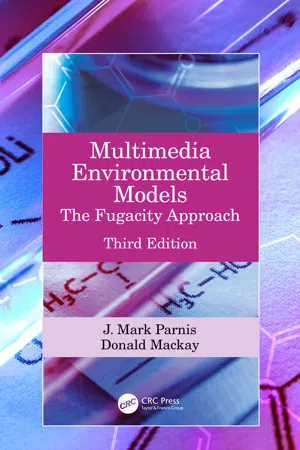
Multimedia Environmental Models
The Fugacity Approach
J. Mark Parnis, Donald Mackay
- 287 pages
- English
- ePUB (mobile friendly)
- Available on iOS & Android
Multimedia Environmental Models
The Fugacity Approach
J. Mark Parnis, Donald Mackay
About This Book
Multimedia Environmental Models: The Fugacity Approach, Third Edition, takes a broad approach of viewing chemical behavior in the total biosphere of connected biotic and abiotic compartments. Chemicals are subject to the laws of "mass balance, " a constraint that provides the opportunity to establish quantitative expressions for chemical fate that are central to chemical management and regulatory legislation.
This book employs both the conventional concentration-based procedures and those based on application of the more elegant and powerful concept of fugacity to characterize equilibrium, steady-state distribution, and time-dependent transport between environmental phases such as air, water, and soil. Organic chemicals are emphasized because they are more easily generalized when assessing environmental behavior.
Features
-
- Illustrates professional approaches to calculating the fate of chemicals in the environment
-
- Explicitly details all worked examples in an annotated step-by-step fashion
-
- Presents real-life freely downloadable models of use to government, industry, and private consulting professionals and students alike
-
- Clarifies symbols and notation
Frequently asked questions
Information
1 Basic Concepts
The Essentials
1.1 Introduction
Table of contents
- Cover
- Half Title
- Title Page
- Copyright Page
- Table of Contents
- Preface
- Acknowledgments
- Authors
- Chapter 1 Basic Concepts
- Chapter 2 Equilibrium Partitioning
- Chapter 3 Advection and Reaction
- Chapter 4 Transport within and between Compartments
- Chapter 5 Evaluative Fugacity Models and Calculations
- Chapter 6 Specific Fugacity Models and Calculations
- Chapter 7 Chemical Uptake by Organisms
- Chapter 8 Human Health
- Appendix A: Estimated Properties of Chemicals of Environmental Concern for use in Modeling Exercises
- Appendix B: Units
- References
- Index